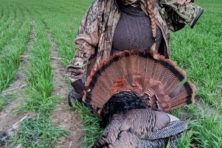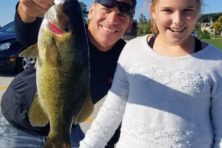Wild Things: Tagged Bass Cruising the Bay
- Share
- Tweet
- Pin
- Share

Scientists are hoping anglers will help with data collection
by KEVIN NAZE, [email protected], Peninsula Pulse contributor
Anglers fishing the waters of Green Bay and its tributaries are being asked to keep an eye out for smallmouth bass with tiny brown tags inserted behind the dorsal fin.
Though there’s no reward for reporting the four-digit number on the tags, former fisheries biologist, research scientist and assistant professor of fisheries Dan Isermann said he believes most anglers will be willing to help researchers.
“We’re already tracking the movements of walleyes, whitefish and muskies in Green Bay and some of the rivers,” Isermann said. “Now we’re looking at smallmouth bass.”
In recent weeks, researchers tagged 210 bass spread across seven locations: Eagle Harbor, Egg Harbor, Sawyer Harbor and the Peshtigo, Oconto, Menominee and Cedar rivers. The fish ranged in size from about 13-1/2 to 22 inches.
Isermann, who leads the U.S. Geological Survey’s Wisconsin Cooperative Fishery Research Unit at the University of Wisconsin-Stevens Point, said anglers have already reported tag numbers from six fish. Five were released, and one was kept.
“There are no rewards for the tag, so we’re asking anglers not to remove it,” Isermann said. “Most people let bass go, and our preference is that they would. Releasing the fish allows us to collect more data.”
The tagged bass were captured with fyke nets in Green Bay, and by electrofishing in the rivers. Although anglers will notice the tag on the outside of the fish, what they won’t see is a black cylinder – a tiny transmitter – implanted inside the fish’s body cavity.
“Our plan is to see what [the tagged bass] do over the next three years,” Isermann said. “That’s about how long the transmitters last.”
Isermann is asking anyone who chooses to harvest a tagged fish to retain the transmitter and call 715.346.2178 so arrangements can be made to return it.
He and other Great Lakes scientists have put transmitters inside hundreds of walleye and whitefish in recent years, and they’re tracking the movements of those fish using a network of more than 100 “listening stations” (receivers) in Green Bay and many of its major tributaries.
Early indications are that both species move extensively throughout the bay during the course of the year. Many spawn in rivers, but some are spawning along reefs, islands and shorelines.
If you catch a tagged bass, Isermann asks that you record the four-digit number and call 715.346.2178 with that number, along with when and where the fish was caught.
Watch for Fawns
Most whitetail fawns in northeastern Wisconsin are born the last week of May and first week of June – about 200 days after conception in early to mid-November.
Some fawns don’t make it past their first week. In farm country, their biggest killers are coyotes, vehicles and hay-cutting equipment. Up north, it’s black bears, wolves, coyotes and bobcats.
Because mother deer leave their babies alone for much of the day, many fawns are discovered by people this time of year. Wildlife experts urge well-meaning people to resist the urge to “rescue” the fawns and leave them be.
Almost always, the doe is nearby and is simply waiting for you to move along. Although the fawn may be motionless and seem vulnerable, this is its normal behavior. Fawns are safest when left alone because their colors and patterns help them remain undetected by predators.
Does visit their fawns to nurse very infrequently. If people repeatedly visit a resting fawn, it can prolong separation from the doe and delay needed feeding.
Up north especially, fawns are often left in areas where people might easily find them because those are places predators are less likely to visit.
Don’t touch the animal. Take a photo; then leave it alone.
If a fawn has already been moved from where it was found, it is recommended to return it to the capture site. The notion that a mother will reject the young after being touched by people is largely a myth.
If a fawn is injured or found with its dead mother (or in cases of clear injury or illness for any wildlife), call the Bay Beach Wildlife Sanctuary at 920.391.3685 to get advice.
For more answers to your baby wildlife questions, visit baybeachwildlife.com/1314/Animal-FAQs and dnr.wisconsin.gov/topic/WildlifeHabitat/orphan.

Water-Levels Update
With continued drought, Green Bay and Lake Michigan water levels are now just five inches above long-term averages. Lake levels are 30 inches below the record monthly high, set in 2020, but they’re still three feet higher than the record monthly low, set in 1964.



